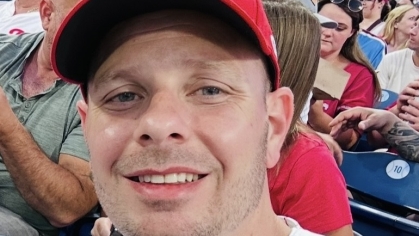Alum Mary Swigonski graduated with her Ph.D. in social work from Rutgers School of Social Work in 1987. Since then, she has been working in social work education. Recently, she published her debut novel, Letters from Eleanor Roosevelt, which follows the journey of fictional character Joan Zatańczy, a social worker. The novel is a celebration of the strength of women and of the power of Mrs. Roosevelt’s letters in bolstering the strength and resilience of Joan’s character.
We recently spoke with Mary about her journey to social work and what inspired her to write the book.
Tell us about your professional journey in social work.
My journey in social work started with a burst of practicality. As an undergraduate, I had a double major in politics and social work. I was interested in the philosophical elements of politics, but I knew job opportunities were pretty limited in that area. So, I double majored in social work because that had a clear career path, and I wanted to do something with my life that enabled me to be both independent and of service to others.
My undergraduate internship and first job were at the women’s prison, now Edna Mahan Correctional Facility for Women, in Clinton, NJ. Working there opened my eyes to inequality and injustice. The social services department innovated some great programs while I was there, things like case aides in each building, but social work in a correctional facility is a high burnout job. I quickly recognized that I needed to know more about human beings, social institutions, and best practices for intervention.
So, I set off to get my master’s degree and negotiated using my job as my internship. That worked really well until the end of my first year when I realized my second year internship had to be in a new setting. That realization led to an intense job search. I knew I was good at assessments and crisis intervention; I knew those skills were transferable, and I knew I was ready to be released from prison. So I set my sights on something different.
An opportunity in medical social work presented itself. It fulfilled the requirements for the second year internship for my MSW, and for the next five years, I worked with people who needed kidney dialysis. I learned a lot. Medical social work in that area included a lot of information and referral, outreach to community agencies, counseling to help patients and their families cope with the changes in their bodies and their abilities, to deal with issues related to death and dying. I realized was that I was very good at the educational parts of my work.
Why did you choose to attend Rutgers School of Social Work?
As I realized I wanted to teach, I recognized that a career in teaching would require a PhD. So I did my homework and developed a list of every school offering a doctorate in social work that was commutable. I also knew that I would need to keep my job while I was going to school, so residency requirements mattered. I read too many catalogues from too many schools of social work, talked to people I knew who had their PhD, and talked to professors from my MSW program, and ultimately, I choose Rutgers because of what I learned about the faculty. For me, it was always going to be about the faculty: Miriam Dinerman, Isabel Wolock, for their work on health care and women’s issues, Ludwig Geismar for his work on families and preventive social work practice.
And back to your professional journey in social work.
Finishing my PhD course work helped to launch my career in social work education. My first teaching position was at Upsala College in East Orange, NJ, where I quickly learned about the social work education accreditation process. My second job was at Rutgers--Newark, where I learned what it truly means to celebrate diversity. And my third job was at Monmouth University, where I found a home.
What inspired you to write this novel?
While I was teaching at Monmouth University, Dr. Janice Wood Wetzel (Adelphi University) and I were having lunch, and I asked her opinion about the role of social justice in social work. Janice said social justice is important, but she thought human rights are more central to social work practice because they are more specific and concrete. She said, “I could wax poetic about human rights.” I urged her to do so. She did. Her response and our discussion that afternoon became one of those insignificant moments, which, if you are awake and paying attention, change your life.
I read everything I could about human rights. I read Mary Ann Glendon’s A World Made New: Eleanor Roosevelt and the Universal Declaration of Human Rights — Mrs. Roosevelt took on the role of negotiator-in-chief overseeing the drafting of the Declaration! That launched my reading of everything I could find about Eleanor Roosevelt. At one point I read an apocryphal story alleging that after Franklin died and Harry Truman took office, Truman wasn’t sure what to do with Eleanor. She wielded too much informal power in Washington and was too popular among everyday people throughout the country. Because she was so popular, he needed to give her a public role, but he wanted her out of his way. So he sent her to Europe to work with the United Nations; that got her out of the country and out of his hair. But Eleanor’s power and popularity grew internationally with her work at the United Nations. That story solidified Mrs. Roosevelt’s place as a hero for me.
The more I read about Mrs. Roosevelt, the more I discovered the extent of her letter writing. She wrote thousands of letters. If you wrote to her, she answered your letter. Mrs. Bertha Brodsky from Brooklyn, NY, wrote to her telling Mrs. Roosevelt about her need for back surgery so she could get a job; it was a surgery she could not afford. Mrs. Roosevelt not only wrote to Mrs. Brodsky but also arranged the surgery, attended her wedding and became the godmother of her child.
I read about President Franklin Roosevelt’s subsistence homestead program and Mrs. Roosevelt’s deep engagement with the Arthurdale Homestead Project in West Virginia. As I explored the locations of other Homestead Projects, I discovered Jersey Homesteads, which is about an hour from where I live in New Jersey. I also learned that a small group of women from Jersey Homesteads wrote to Mrs. Roosevelt about difficulties that the town was having with their factory. I found a copy of the letter they wrote. But I could find no record of a response. Yet I knew from my research that Mrs. Roosevelt must have replied. I wondered, “what if?” That fed my imagination. This book is the result.
Why did you want to make the protagonist of the novel a social worker?
As I started to write the novel, I knew two things. 1) I wanted the protagonist to be substantively influenced by Eleanor Roosevelt’s work for human rights. 2) I wanted the protagonist to meet Eleanor Roosevelt, and that dictated the time frame for the novel. Additionally, I wanted the protagonist to be a strong woman, but also a woman of her times. Social work just fit with all of those wants.
What were your goals in writing this novel?
More than anything, I wanted the novel to be a celebration of women, our strengths, our struggles, and our contributions to the world. Woven into the text and the story are a wealth of quotes from women throughout history. Also woven into the text and the story are the names and contributions of nearly 100 women.
Foremost among the women celebrated is Eleanor Roosevelt. Yes, she is well known by many, but I don’t think her contributions to the UN Universal Declaration of Human Rights are adequately acknowledged in the United States. I wanted to shine a light on that—which I did in the fictional letters from Mrs. Roosevelt in the book. Ultimately, Letters from Eleanor Roosevelt is the story of Joan Zatańczy and her determination to graduate from Barnard College, the obstacles she encounters, and the secrets she uncovers along the way.
The story begins on the eve of Joan’s 21st birthday as her mother gives Joan a sack of letters from Eleanor Roosevelt, hoping Joan will find a senior thesis topic in them. The story unfolds in Joan’s letters to her best friend, Yanina, an Israeli Kibbutznick. It is the story of Joan’s loss of innocence (her college advisor seduces her), and her growing conflicts (she discovers she is pregnant, files a paternity suit, and faces a threat of dismissal from the college). Joan’s letters are a celebration of the strength of women and of the power of Mrs. Roosevelt’s letters in bolstering the strength and resilience of Joan’s character.
Do you have any hopes for the future of the social work profession?
My hope would be that we grow to be a profession that dedicates itself to work for universal human rights. That we focus on building a world that nurtures and sustains human dignity on the individual, family, and community levels. That we embrace human rights as an operational definition of social and economic justice, and that we lead the vanguard celebrating the contributions and the importance of diversity for human flourishing.
Mary's book, Letters from Eleanor Roosevelt, is available on Amazon.



